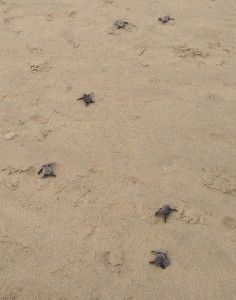I was in Puerto Vallarta last week. For part of the trip, we stayed in a beautiful resort in Nuevo Vallarta, a place to which three different varieties of endangered sea turtles return to lay their eggs. There is a sea turtle hatchery located near the resort that incubates and protects the eggs and then releases the hatchlings in a controlled manner to increase their chances of survival. Visitors can go to the hatchery at sunset to participate in the nightly ritual of releasing the day’s hatchlings.
Locals who work on or near the beach: hotel employees, lifeguards, vendors and citizens participate in the efforts to save the turtles by noticing when a turtle climbs out of the ocean and creates a nest. The spot is marked by the observer and reported to the hatchery. The hatchery workers dig up the nest and relocate it to the hatchery where it will be kept safe for the approximately 60 days it takes for the eggs to hatch.
Mornings, before the sun heats the air, are beautiful here. I found a quiet, secluded spot behind the hotel where I practiced yoga in the morning. There’s a beautiful, outdoor wedding chapel that overlooks the ocean and is surrounded by a huge expanse of grass and tropical trees. With the sounds of the ocean as a backdrop, this is an idyllic place to practice. As I rolled out my mat, I noticed one of the black birds that frequent the area shaking its head to subdue a baby turtle that the bird held in its beak. I went back and forth between cursing the bird and accepting this as part of the cycle of the life of a turtle. Only 2 out of 1,000 baby turtles will live to reproduce at age 6-8.
As I turned back to my mat, I noticed some movement in the grass and an increase in the number of black birds in the area. I walked over to the movement and saw a hatchling, struggling to move about in the grass. I picked it up as I saw another and another. I had six of them in my hands, each trying to get away and make it to the water. Their chances were slim. Between them and the water was a rock garden, a two foot high stone wall, a four foot drop to the 50 yards of treacherous sand and an untold number of predators hovering overhead.
I took the circuitous route, through the hotel grounds, to the beach. The whole time, my six charges were struggling to get out of my hands. Once I got close to the water’s edge, I put them down, far enough back from the water to give them opportunity to smell the sand and water. No one fully understands how the turtles find their way back to the beach on which they hatched to lay their eggs in adulthood. Allowing them the opportunity to take in their environment might increase their chances of making it back to reproduce.
Five of the six took right off and ran into the water. The sixth seemed disoriented and hung around for a few minutes before heading into the water. I went back to the grassy spot and found four more hatchlings. I repeated the release ritual and went back to find one more, which I also released.
I wondered how the mother turtle had made it up this far to lay her eggs. The area was surrounded by obstacles, including a fence, and the area was planted and manicured. I looked around, with no luck, to see if I could find any others.
I checked back a few times during the day to see if any others had hatched and found none. It gives me a feeling of satisfaction to know that I helped 11 little souls survive certain death at the hands of the heat and predators. Had I not gone to the area to practice yoga, none of them would, probably, have made it.
See, yoga does save lives.





